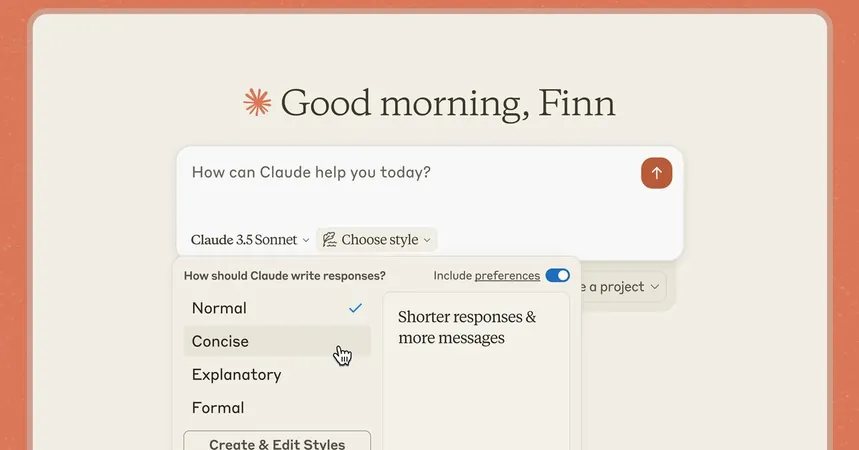
Revolutionizing AI Interaction: Anthropic's Claude AI Finally Gets Your Writing Style!
2024-11-26
Author: Charlotte
Anthropic has just rolled out an exciting new feature for its Claude AI assistant that promises to transform the way users interact with the chatbot. This innovative update allows users to mold Claude's responses to match their personal writing styles, giving them greater control over how the AI communicates across a variety of tasks.
With these new custom styles available to all Claude users, anyone can easily train the AI to reflect their unique communication style or choose from a selection of preset options for a quick adjustment to tone and detail. Whether you're drafting complex technical documents or crafting professional emails, this update is aimed at making AI interactions more personal and natural.
Three user-friendly preset styles have been introduced:
- **Formal** for “clear and polished” text,
- **Concise** for brief and direct responses,
- **Explanatory** for educational replies that require additional detail.
But if those options don’t quite fit the bill, users can create custom styles by uploading sample content that exemplifies their desired writing mannerisms. This flexibility enables Claude to adapt and respond in a way that resonates with the user's preferences.
Scott White, Claude’s Product Leader, highlighted the adaptable nature of this feature in the announcement, stating, “You might want in-depth explanations when learning something new or quick, straight-to-the-point answers when you're in a hurry. The beauty of this update is that you can set your preferences once, ensuring every interaction feels just right for you.”
This innovative update isn’t merely a leap for Anthropic; it's part of a broader trend in AI development. Rivals like OpenAI’s ChatGPT and Google’s Gemini already offer similar tailoring features, allowing users to adjust their interactions based on personal styles. Interestingly, Gemini even lets users modify the tone or level of detail in Gmail drafts, heightening its usability in professional settings. Apple’s writing tools, embedded within its intelligence services, likewise provide style presets to enhance user experience.
The introduction of Claude’s custom writing styles not only enhances the application of AI but also ensures that interactions feel more genuine and contextually appropriate. As AI continues to evolve, features like these encourage users to engage more deeply with technology, building a bridge between human communication and artificial intelligence. The question remains—will Claude set the bar for AI interactions, or will competitors find ways to outperform in this rapidly advancing field?









 Brasil (PT)
Brasil (PT)
 Canada (EN)
Canada (EN)
 Chile (ES)
Chile (ES)
 España (ES)
España (ES)
 France (FR)
France (FR)
 Hong Kong (EN)
Hong Kong (EN)
 Italia (IT)
Italia (IT)
 日本 (JA)
日本 (JA)
 Magyarország (HU)
Magyarország (HU)
 Norge (NO)
Norge (NO)
 Polska (PL)
Polska (PL)
 Schweiz (DE)
Schweiz (DE)
 Singapore (EN)
Singapore (EN)
 Sverige (SV)
Sverige (SV)
 Suomi (FI)
Suomi (FI)
 Türkiye (TR)
Türkiye (TR)